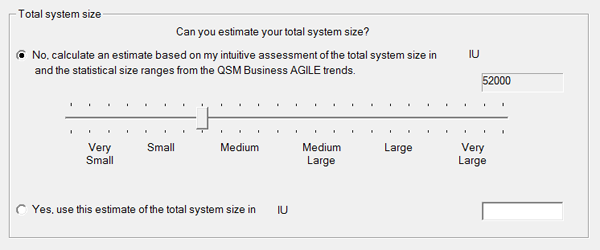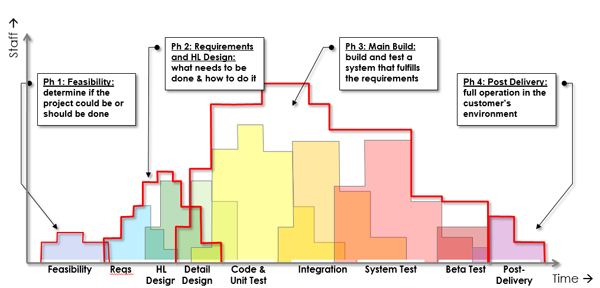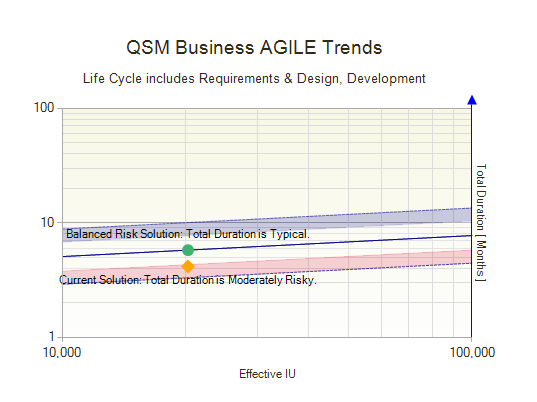Beginning with the release of SLIM-Suite v8.1, two new SLIM-Estimate solution methods were added to let you see what a “typical” project would look like: that is, the resources it would require, based upon historical projects from either the QSM database or your own. The two methods are:
- Solve from Trends Wizard
- Trend Based Solution
SLIM-Estimate provides several different ways to solve the software production equation and produce an estimate. The solution method you select depends upon the information you have available. The traditional methods, known as Quick Estimate Wizard and Detailed Method, take inputs of Size and Productivity (PI), and calculate Effort and Time. The Solve for Size Wizard, perfect for time-boxed estimates, takes inputs of Time, Effort, and PI, and determines the amount of functionality that combination of resources can produce.
The trend solutions require only one input – Size. Using the specified Primary Trend Group, Time and Effort are read from the average trend line and productivity (PI) is calculated. These methods extend the capabilities of producing a defensible project estimates very early in the life cycle. You can determine the feasibility of project goals, assess risk, and manage stakeholder expectations even if all you can estimate is a relative application size, expressed as a “T-shirt” or bin size, as shown in the figure below.

Why two trend based solutions?
The two trend based solutions differ only in the source of Phase Tuning data. SLIM-Estimate’s ability to model any development life cycle is manifest by configuring the relative “size” of SLIM’s four high-level phases (outlined in red below), in Time and Effort. The amount of work to be done in phases 1, 2, and 4, is specified as a percent of Phase 3 Duration and Effort. You can set them by fixed duration and/or specific dates, but using percentages is more common since it preserves the integrity of the life cycle model regardless of project size.

Solve from Trends Wizard – phase tuning data is read from the Primary Trend. Whether you are creating a new workbook or running the wizard as an alternative solution, phase tuning data will represent the average for the Primary Trend Group. Existing phase tuning settings in your template will be overwritten.
Trend Based Solution – phase tuning data is read from the settings on the Solution Assumptions screen. Regardless of whether your template uses the QSM “Automatic” settings, you have manually configured your phase tuning, or you are taking advantage of SLIM’s powerful History Tuning settings, the Trend Based solution will only read Time and Effort from the trends and preserve your phase tuning settings.
Comparative Risk Analysis
Remember that any changes to information across all three tabs of the Solution Assumptions area will calculate an alternative scenario. This allows you to very rapidly explore the benefits and risks of a range of potential project outcomes. So, you can easily run both trend based solutions alongside any other scenario to assess their relative merits.
This is a key feature of our new cloud-based product, SLIM-WebServices. Feasibility and Estimation project estimates are compared to what is known as the Balanced Risk Solution, which takes size and resource constraints as inputs, and runs one of the trend based solutions.
Computing “typical” solutions from historical trends answers the question, “Could the average developer of this project type achieve our project goals?”

I hope you will consider using either the Solve from Trends Wizard or the Trend Based Solution in your estimate analysis. It can save you a lot of time by quickly identifying project goals that are unreasonable, or risky at best.
